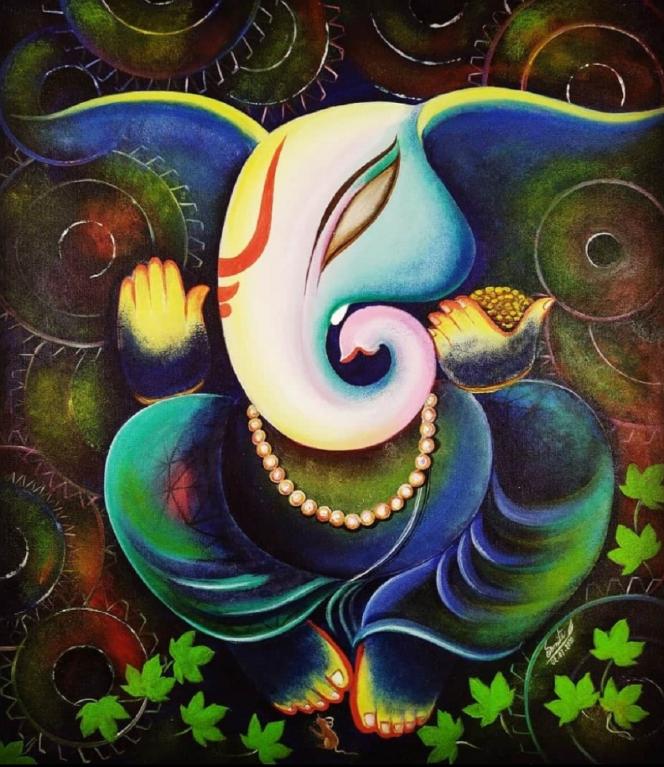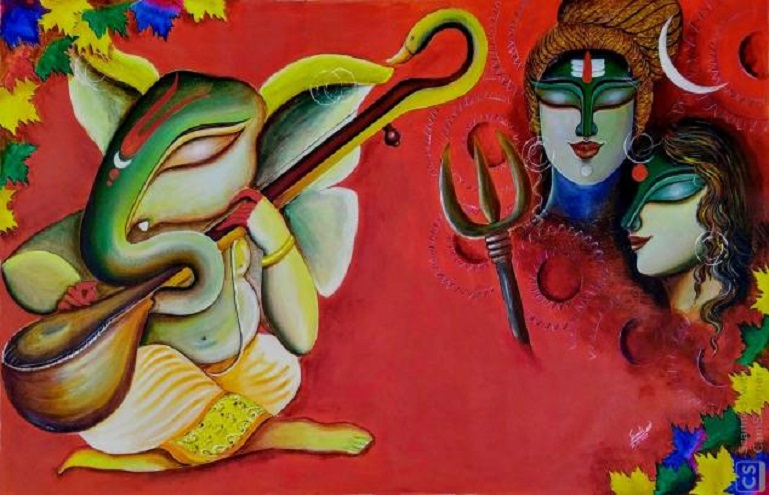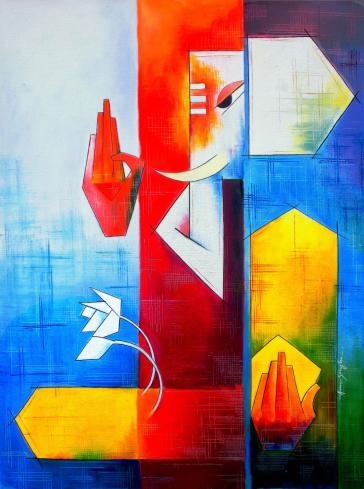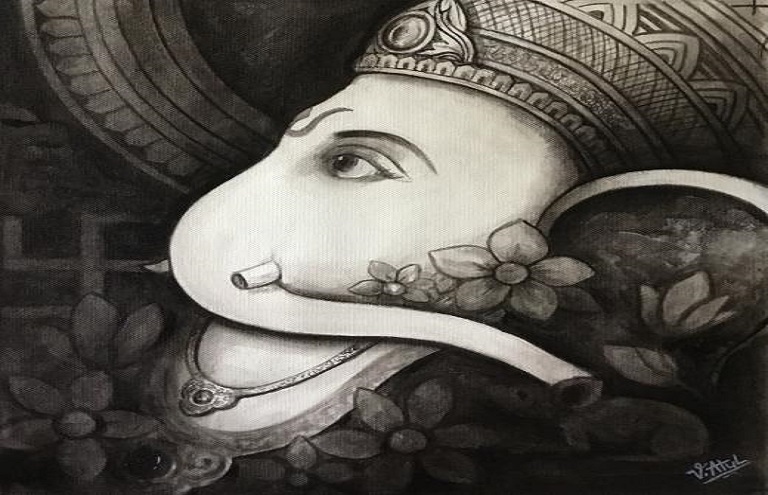
Also known as ‘Achintya’, ‘Avyakta’, and ‘Ananta’- Ganesha is the lord of all - the only consciousness that penetrates and brings in the universe in order. In India, whenever a ‘Shubh’ or Prosperous event takes place, Lord Ganesha is the first God to be remembered.
Most Hindu household, even in the 20th century look to adorn one or some of their walls with religious artwork. The most common of all God paintings we find in any Indian art gallery is the Ganesha paintings, reason being the flexibility and creativity the artists and art lovers have found in the portrayal of Lord Ganesha. A random look at any online art gallery will indicate how Ganesha can be easily depicted in traditional as well as modern art. Ganpati is known to mingle in both mythical and artistic segments to your chosen decor corner.
If you are also an ardent admirer of Ganesha and wish to know more about the various ways the God is depicted, this article is for you.
Ganesha Paintings - Elements and their Symbolic Representation
Ganesha has been represented in various forms and patterns for over quite a lot of years. He is said to be associated with the energy wheel (1st Chakra) representing survival, well-being, and conservation. Ganesh is portrayed seated, standing, dancing, playing musical instruments, doing yoga, and eating laddoos. He is not only looked upon as God for all but also a friend to children – celebrated with pomp and show on Ganesh Chaturthi. While different paintings depict different faces of the god, every portrayal is held in high esteem by the owners to seek protection. Having a brief understanding of the iconography of each element of Ganesha paintings helps a lot before you buy and gift paintings of Ganesh.
Let’s check out.
The Elephant head or ‘Gaj Mukh’
As the mythological facts state- an elephant’s head was used to revive Ganesh who was beheaded by Shiva in utmost aggression and commotion. While pleasing the kid with a new head- Shiva gifted him a blessing of being worshipped first before any deities. The animal’s head and human body symbolizes not only wisdom and a fair understanding of the world; also, an intellect that one must possess to attain perfection in his or her life.

Image 2: https://indianartideas.in/artwork/ishanputra/16720
Trunk Facing Left
While different artists portray Ganesh differently- when we talk about ‘Vastu Ganesh’, we usually see the image of Ganesha with the trunk made towards the left. The left side in such paintings represent ‘Feminine Energy’.

Image 3: https://indianartideas.in/artwork/vinayaka/15736
Just as the female characteristics, this side of the trunk represents a calmer side of the Ganesh and is usually placed at places used for relaxation activities such as Yoga and meditation. Such a Ganesha Painting is used as a decor piece for homes, thus ensuring peace and calmness all together.
Trunk Facing Right
When called as Dakshinabhimukhi or Siddhi Vinayak- the artist usually talks about the painting that has the trunk drawn to the right-hand side. This symbolizes ‘Masculine Energy’. In such a form of portrait- his energy is said to be powerful and antagonistic. When worshipped with the right trunk, one is said to seek results which are fast and quick, making it important to follow an aggressive force to please the God.
One With a Broken or Missing Tusk
With joint hands, we also refer to him as ‘Ek Danta’- the one with a single tooth- highlighting the broken tusk in the image also given below.

Image 4: https://indianartideas.in/artwork/ganesha-57/17011
The tusk was broken by Ganesha himself to use as an alternative for a pen to write the legendary ‘Mahabharat’. It is the symbolism of a wise man who is absolutely beyond duality. As Ek Danta states, wisdom should be a characteristic that should allow the individual to see every equally and as an integral whole.
The Upraised Hand
Being part of almost all god and deities’ paintings, the upraised hand refers to the act of showering one's blessing to the devotees who stand with joint hands. This action makes sure that the ultimate power is there to save and protect them from any kind of negative occurrences.

Image 5: https://indianartideas.in/artwork/lord-ganesha/14560
Along with the apprised hand, there is a resting one too which denotes the very giving nature of the god. The hand also is a gesture to invite the devotees to come and bow down for heartfelt blessings; explaining that humans created out three elements and this will be dissolved in the earth itself.
How has depiction of Ganesha changed over time?
From a simple elephant being depicted as Lord Ganesha to the one being painted in modern art has made the visual explanation quite diverse. While the theme remains almost similar, the medium and the style has changed to cater to the changing tastes of the art lovers.
Ganesh is the only god that holds an iconic representation of love, power, and blessings all in one. While the style has changed from time to time the basic elements, as mentioned above, have remained the same. He is usually shown with arms, in numbers of four to sixteen. When the depiction is expressed with four hands, the lower left hand is usually shown holding his favorite sweets- Laddoos. There is an axe in the upper right hand and a noose in the upper left hand. In traditional paintings, Ganesha is seen holding his broken tusk in his upper right hand while the modern paintings today depict the same hand rising high to pour blessings on his devotees. It is interesting to notice even the items Lord Ganesh holds that varies from that of a lily, discus, bowl of sweets, musical instrument, and more, usually depicted differently by different artists.
Wrap up:
Ganesha, also known as Ganpati and Pillaiyar, is said to be associated with luck and prosperity, therefore frequently finds place in people’s home and office. Ganesha paintings, nowadays, are created in such a way that they blend with the décor of both traditional as well as modern households.
Among the paintings inspired by Hindu religion, Ganesha paintings are the popular not only in India but around the world. It is because Ganesha paintings are not only considered as just a piece of art – but also a perfect choice for gifting on occasions like marriage, housewarmings, new beginnings, etc.
22People usually look for perfect artwork that holds not only the god figure but also the colors and textures matching their own wall. This is when they should get in touch with various professional artists. Visit Indianartideas, a leading online art gallery in India where you can find up to 10,000+ Ganesha paintings in the form of contemporary art, modern art, and traditional art.





















